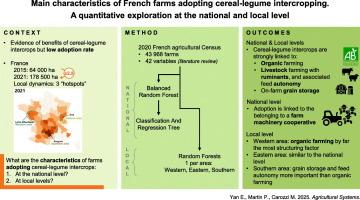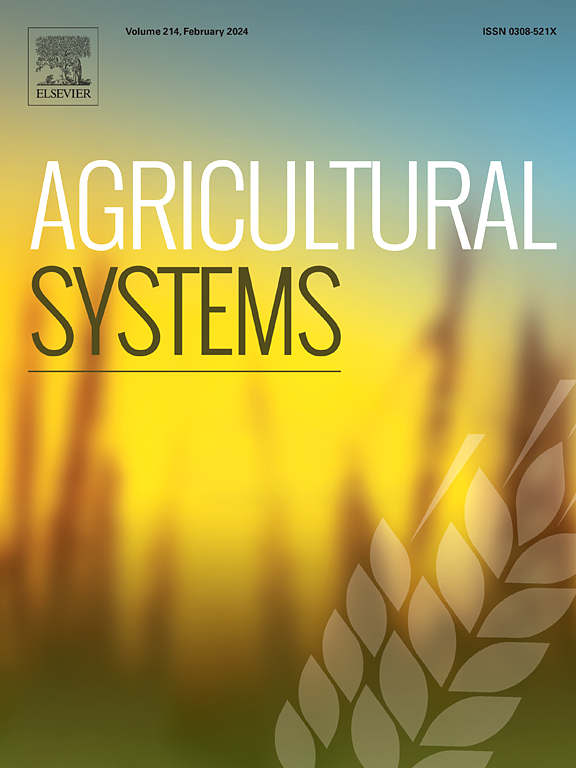Main characteristics of French farms adopting cereal–legume intercropping: A quantitative exploration at the national and local levels
IF 6.1
1区 农林科学
Q1 AGRICULTURE, MULTIDISCIPLINARY
引用次数: 0
Abstract
CONTEXT
Cereal–legume intercropping is a diversification practice that offers many advantages, especially in low-input systems. However, its adoption remains low on European farms, as technical and economic barriers hinder its development. In recent years, an increase in the proportion of arable land cultivated with cereal–legume intercrops has been observed in France. Three areas in particular – in Western, Eastern and Southern France – seem to be particularly dynamic.
OBJECTIVE
This study aimed (i) to identify the main farm characteristics associated with the presence of cereal–legume intercrops at the national level in France and (ii) to highlight more specific characteristics that could explain the particular dynamics observed in each focus region.
METHODS
We analysed data from the 2020 French Agricultural Census for 43,968 farms representative of the French arable crop, livestock, and mixed crop–livestock farming systems. Through a literature review, we identified key factors linked to the presence of cereal–legume intercrops and related them to 42 variables in the census. At the national level, the most important of these variables were identified and interpreted using a balanced random forest and a classification and regression tree (CART). We tested the CART obtained at the national level in the Western, Eastern, and Southern areas and conducted a random forest analysis for each area to identify local particularities.
RESULTS AND CONCLUSION
At the national level, the presence of cereal–legume intercropping was strongly linked to organic farming and the presence of livestock, especially ruminants. These intercrops were prevalent on farms with high feed autonomy for the cattle and sheep. Additionally, they were commonly observed on farms with grain storage, possibly indicating feed autonomy, on-farm transformation, or marketing outside of agricultural cooperatives. The belonging to a farm machinery cooperative was also strongly associated with cereal–legume intercropping, likely because these cooperatives give farmers access to specific machinery and provide opportunities for knowledge exchange regarding their practices. Similar characteristics were identified at the local level; organic farming was pivotal in the Western and Eastern areas, followed by feed autonomy for cattle. In the Southern area, however, on-farm grain storage capacity was dominant, likely due to longstanding efforts to achieve feed autonomy.
SIGNIFICANCE
This exhaustive study on French farms identified key farm characteristics strongly linked to cereal–legume intercrops adoption. This insight is critical for promoting this practice, whether through national public policies or local farming support services. The methodology proposed can be easily reproduced to investigate other farming practices at different spatial scales.

法国采用谷物-豆类间作的农场的主要特征:国家和地方层面的定量研究
内容提要 谷物-豆类间作是一种多样化耕作方法,具有许多优点,尤其是在低投入系统中。然而,由于技术和经济障碍阻碍了其发展,欧洲农场的采用率仍然很低。近年来,在法国,谷物与豆类间作的耕地比例有所增加。本研究旨在:(i) 在法国全国范围内确定与谷物-豆类间作相关的主要农场特征;(ii) 强调可解释各重点地区所观察到的特殊动态的更多具体特征。方法 我们分析了 2020 年法国农业普查中 43968 个农场的数据,这些农场代表了法国的耕地作物、牲畜和作物-牲畜混合耕作系统。通过文献回顾,我们确定了与谷物-豆类间作相关的关键因素,并将其与普查中的 42 个变量联系起来。在国家层面,我们使用平衡随机森林和分类与回归树(CART)识别并解释了这些变量中最重要的变量。我们在西部、东部和南部地区测试了在全国范围内获得的 CART,并对每个地区进行了随机森林分析,以确定当地的特殊性。结果与结论在全国范围内,谷物-豆类间作的存在与有机农业和牲畜(尤其是反刍动物)的存在密切相关。这些间作作物在牛羊饲料自主性高的农场很普遍。此外,在有谷物储藏的农场中也常见到这些间作作物,这可能表明饲料自主、农场转型或在农业合作社之外进行销售。加入农机合作社也与谷物-豆类间作种植密切相关,这可能是因为这些合作社让农民有机会获得特定的机械,并为他们的实践提供了交流知识的机会。在地方一级也发现了类似的特征;在西部和东部地区,有机耕作至关重要,其次是牛的饲料自主权。这项对法国农场的详尽研究确定了与采用谷物-豆类间作作物密切相关的关键农场特征。无论是通过国家公共政策还是地方农业支持服务,这一洞察力对于推广这一做法都至关重要。所提出的方法可以很容易地复制,以调查不同空间尺度上的其他耕作方法。
本文章由计算机程序翻译,如有差异,请以英文原文为准。
求助全文
约1分钟内获得全文
求助全文
来源期刊

Agricultural Systems
农林科学-农业综合
CiteScore
13.30
自引率
7.60%
发文量
174
审稿时长
30 days
期刊介绍:
Agricultural Systems is an international journal that deals with interactions - among the components of agricultural systems, among hierarchical levels of agricultural systems, between agricultural and other land use systems, and between agricultural systems and their natural, social and economic environments.
The scope includes the development and application of systems analysis methodologies in the following areas:
Systems approaches in the sustainable intensification of agriculture; pathways for sustainable intensification; crop-livestock integration; farm-level resource allocation; quantification of benefits and trade-offs at farm to landscape levels; integrative, participatory and dynamic modelling approaches for qualitative and quantitative assessments of agricultural systems and decision making;
The interactions between agricultural and non-agricultural landscapes; the multiple services of agricultural systems; food security and the environment;
Global change and adaptation science; transformational adaptations as driven by changes in climate, policy, values and attitudes influencing the design of farming systems;
Development and application of farming systems design tools and methods for impact, scenario and case study analysis; managing the complexities of dynamic agricultural systems; innovation systems and multi stakeholder arrangements that support or promote change and (or) inform policy decisions.
 求助内容:
求助内容: 应助结果提醒方式:
应助结果提醒方式:


